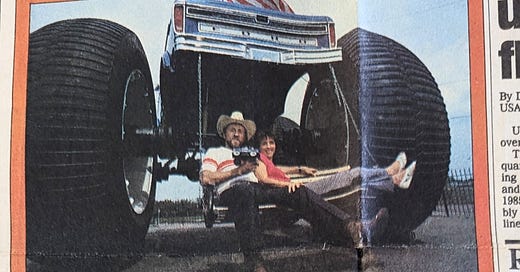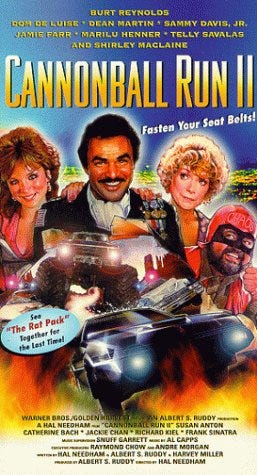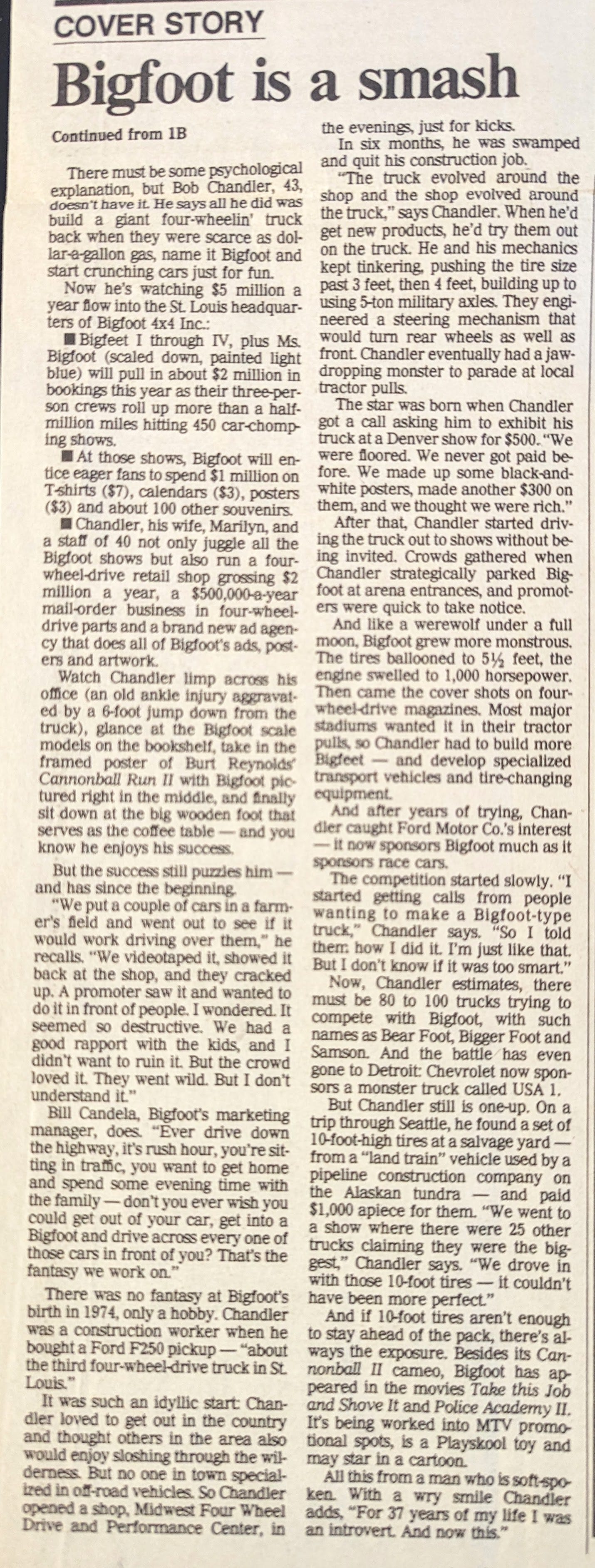Bigfoot and Me
That time I interviewed the inventor of monster trucks and rode in one during a show
There I was watching a recent New Jersey Devils home hockey game on TV when a commercial popped up for an event that I never knew existed – a Monster Jam, which would take place in that very same arena in a few weeks.
And I thought, huh, I actually rode in a monster truck for a show at the Missouri State Fair in 1985 while I was working on a story about the guy who invented the monster truck, Bob Chandler.
Bob drove, of course. I was white-knuckling it in the passenger seat. But after the show, once I climbed ten feet down out of the truck, kids rushed up and asked for my autograph. Turns out just riding in a monster truck can turn you into somebody.
In the summer of 1985 – my first year as a reporter at USA Today – I was getting a reputation for quirky business stories (see: Zamboni). My editor came by and suggested I do a feature about Bigfoot. I knew nothing of said Bigfoot, but with a little research found out that outside of St. Louis, Bob Chandler had built what is recognized as the first monster truck, which he named Bigfoot. And the truck was becoming a celebrity. It had even made an appearance in Burt Reynolds’ Cannonball Run II.
So off I went to Missouri to visit the headquarters of Bigfoot 4X4 Inc., which had become a $5 million a year operation with 40 employees. I remember interviewing Chandler as we sat around a coffee table that was a big wooden foot. And he told me that the whole Bigfoot phenomenon was an accident, and that he still didn’t understand its appeal.
Here’s the backstory: In 1974, Chandler was a construction worker who bought a Ford F250 four-wheel drive pickup truck. He got into off-roading in his truck and figured others would like it, too. But there weren’t any shops in town catering to that pastime. So he opened one, Midwest Four Wheel Drive and Performance Center.
Chandler and his mechanics liked tinkering, so they kept putting bigger tires on the F250 and adding steering systems and axles that would let the truck drive over bigger things. Eventually they found tires that were ten feet high and put them on the truck.
Here’s what Chandler told me happened next: “We put a couple of cars in a farmer’s field and went out to see if it would work driving over them. We videotaped it, showed it back at the shop, and they cracked up. A promoter saw it and wanted to do it in front of people. I wondered. It seemed so destructive. We had a good rapport with the kids, and I didn’t want to ruin it. But the crowd loved it. They went wild. But I don’t understand it.”
By the time I met Chandler, the business had four Bigfoot trucks and a Ms. Bigfoot (scaled down, painted light blue). Between them, they were doing 450 shows a year.
Chandler thought I should experience a show. I didn’t realize he meant I should experience one from inside the truck. Here’s how I described it in the story:
“Here he comes,” wails an announcer, “the original monnnnster trrrruck, Biiiiigfoooooot!” The star takes its cue, roars to life and rips into three junk cars bunched under the spotlight. The front end of the 14,000-pound Ford truck pops into the air, wheels momentarily spinning free. The modified monster then slams down on one rooftop. Glass shatters, the car’s roof collapses, and Bigfoot bounces over all three cars, turns around and heads back for more.
This time the driver gets more height and the truck pounds down like a wrecking ball. The arm-thick treads chew up the cars as Bigfoot powers across the pile of junk and rolls to a halt. The driver opens the door and waves to a cheering, rollicking crowd.
Yes, I was inside for all of that.
Then with the crowd cheering, I jumped out, a newly-birthed star, happy that none of my limbs had been shaken off of my body.
Nearly four decades later, I realize there is something else that Chandler did that I didn’t fully appreciate at the time: Chandler created a market category called monster trucks. As Bigfoot got popular, others wanted to build similar trucks. They’d call Chandler to get some insight. “So I told them how I did it,” he told me in 1985. “I’m just like that. But I don’t know if it was too smart.”
Actually, if I put on my category design hat, I’d say it was really smart. Helping form a market category legitimized Bigfoot. The act became more than an oddity – it turned into a new form of entertainment. If Chandler had held tight to his secrets, there might not be Monster Jams or so many other monster truck shows filling big-city arenas today.
Bigfoot 4X4 is now a huge business. It does shows all over the world – even the O2 Arena in London. It has a team of 12 drivers, including Chandler, now in his eighties, and sells clothing, toys, posters and coffee mugs. Creating a far bigger pie benefited Chandler and Bigfoot.
As a footnote, Bigfoot does not appear in the Monster Jam series. Apparently there was a dispute with the organizers in 1998 over licensing of video footage, and Bigfoot stomped out, never to return.
Which saves me from having any reason to buy a ticket to the upcoming show in Newark. For one thing, I’ve been spoiled. If I’m not going to actually be in a monster truck show, why bother? And for another thing, it’s not really my style. I drive a Mini Cooper.
The Bigfoot story in USA Today is not available online. Here are images of the story as it appeared on September 10, 1985.






